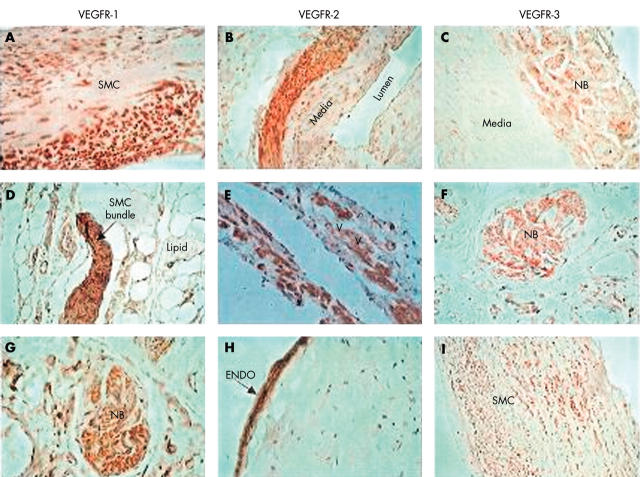Figure 2.
Immunohistology for vascular endothelial growth factor receptors (VEGFRs). (A–C) Sections of uterine artery. (A, B) Localisation of VEGFR-1 and VEGFR-2 to medial smooth muscle cells (SMCs) in the arterial wall (original magnification, ×200) with no staining of luminal endothelium. (C) Localisation of VEGFR-3 to small nerve bundles (NB), SMCs, and extracellular matrix (ECM) in the adventitia (original magnification, ×200). (D–F) Sections of abdominal aortic aneurysm (AAA) tissue. (D) Staining for VEGFR-1 is localised to a bundle of SMCs within the adventitia (original magnification, ×400) and (E) localisation of VEGFR-2 to SMC surrounding the vasa vasorum in the adventitia, but no staining of the endothelium (original magnification, ×400). (F) Staining for VEGFR-3 in AAA, red positive staining is localised to a nerve bundle in the adventitia but no staining of the nearby vasa vasorum (original magnification, ×400). (G–I) Sections of carotid atheroma. (G) A section of atheroma from an atherosclerotic artery and localisation of VEGFR-1 to a nerve bundle with some ECM staining but no staining of nearby vasa vasorum (original magnification, ×400). (H, I) Sections of a carotid atheroma stained for VEGFR-2 and VEGFR-3, respectively. Highly positive staining for VEGFR-2 is localised to the luminal endothelial (ENDO) (original magnification, ×400), whereas VEGFR-3 is localised to SMCs in the media and adventitia, with no luminal endothelial staining (original magnification, ×200). In all figures, positive staining by antibodies is indicated by brown or red/pink. The haematoxylin counterstain stains pale blue.

